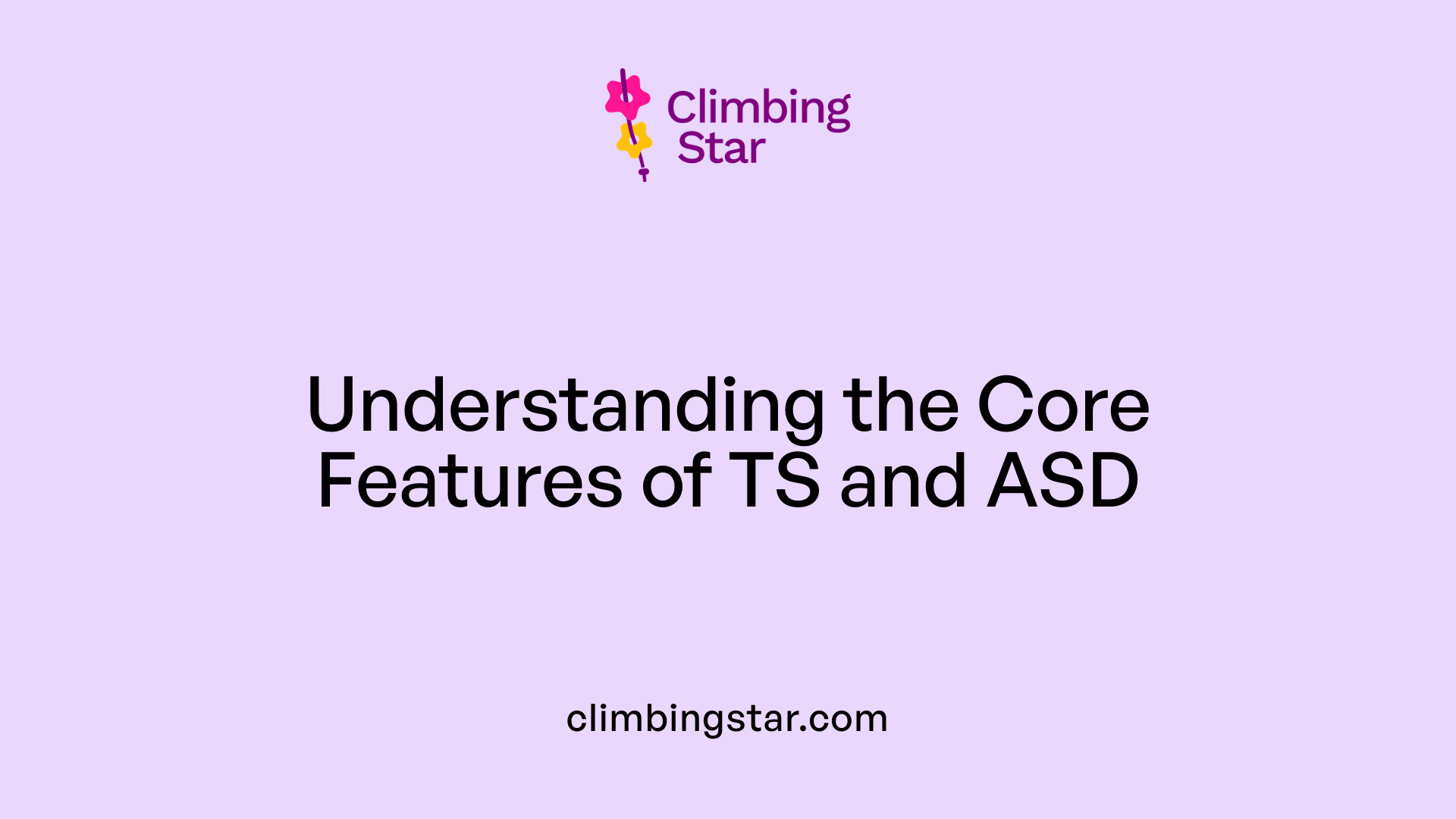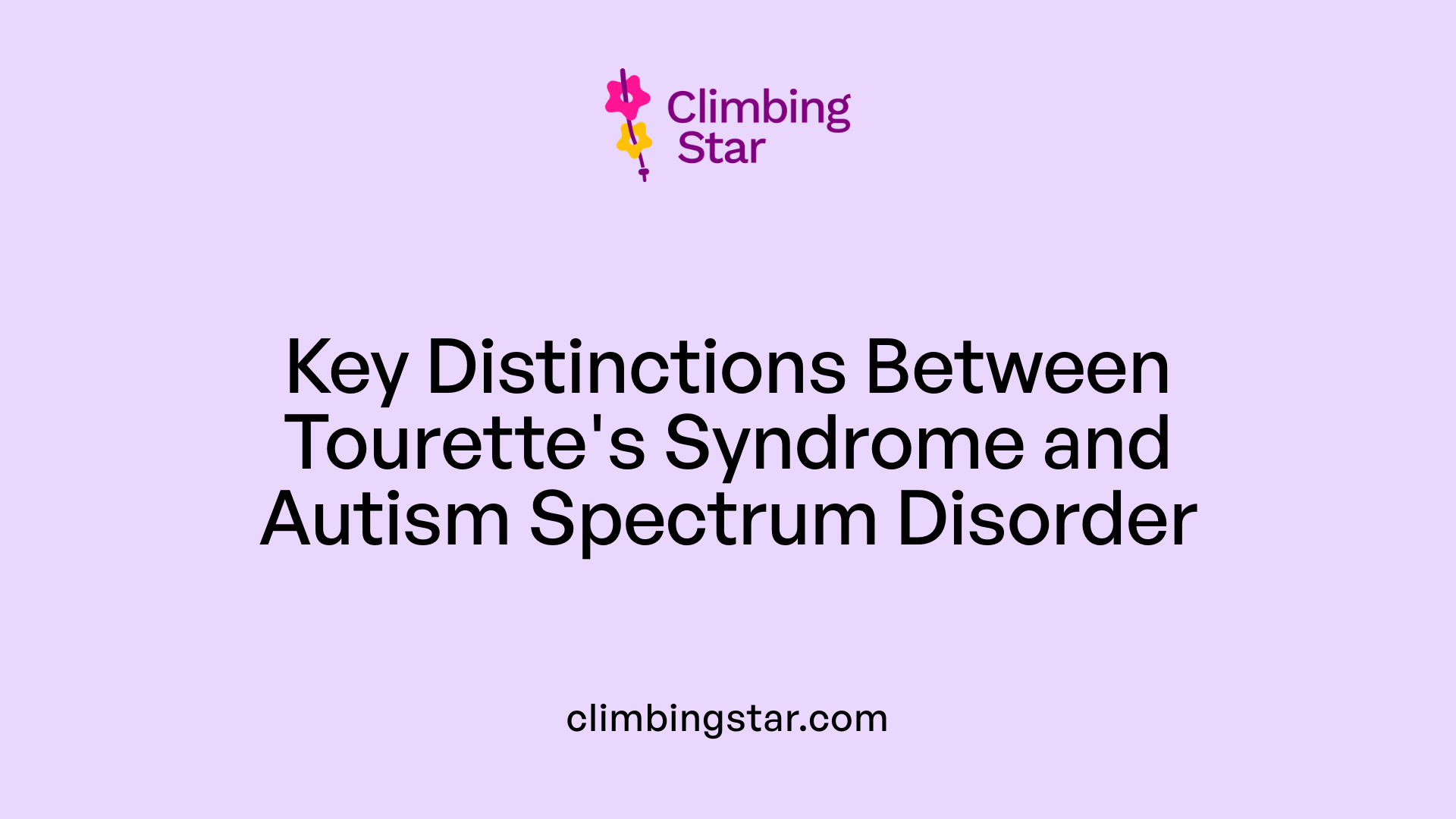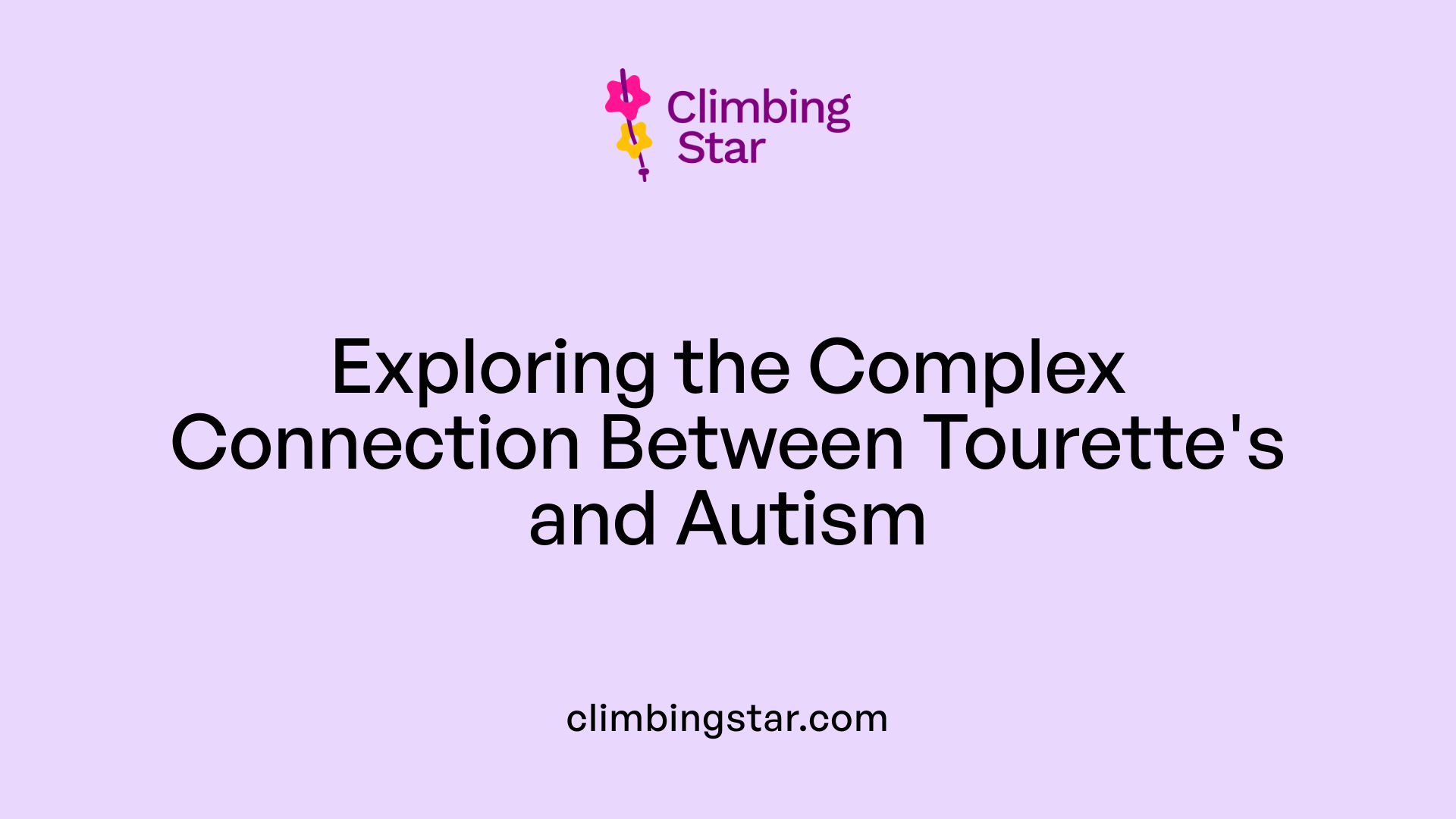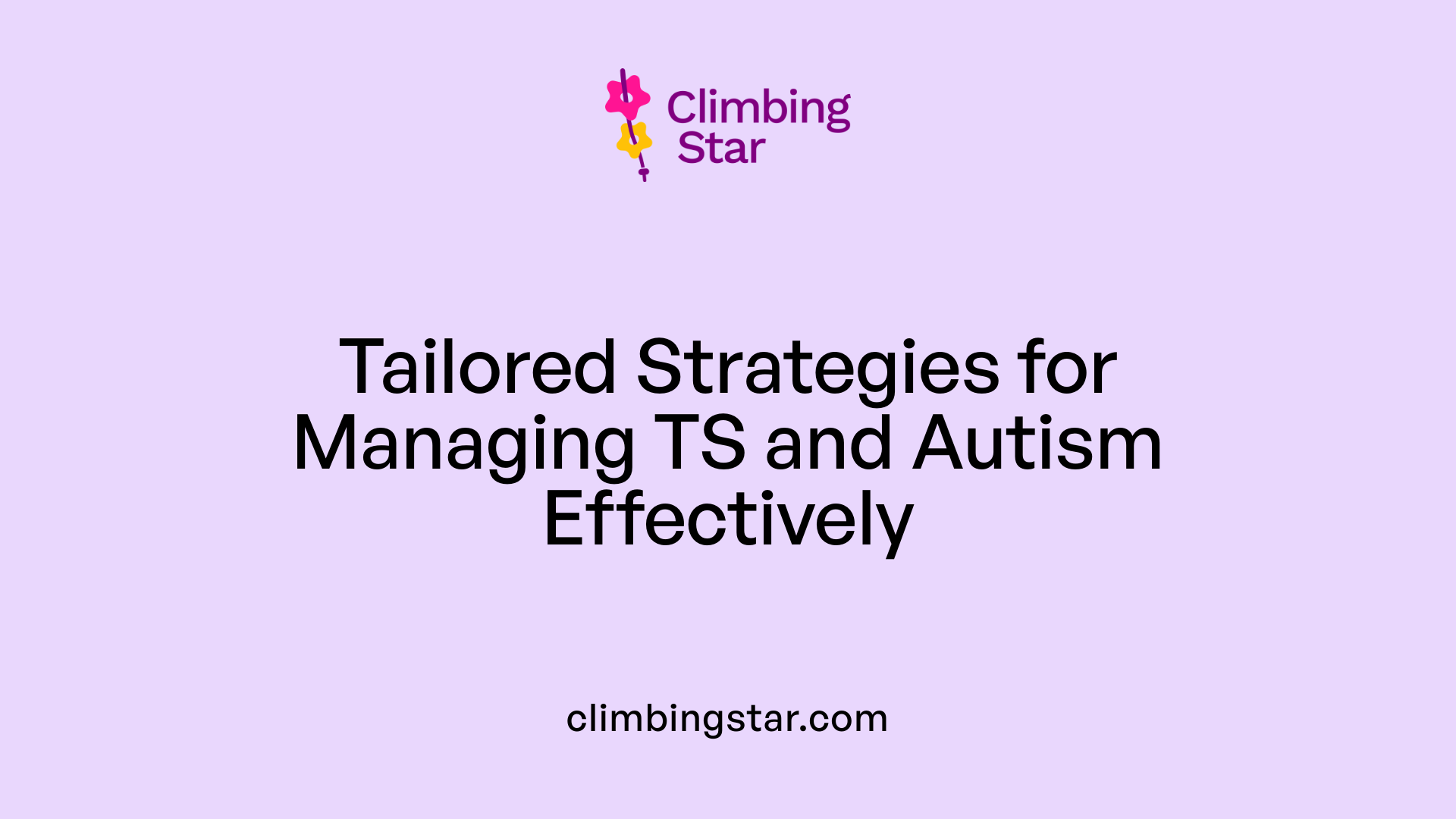Exploring Two Neurodevelopmental Conditions
Tourette's Syndrome (TS) and Autism Spectrum Disorder (ASD) are both neurodevelopmental conditions that often impact children and can affect males more frequently. Despite some overlapping features, they are distinct disorders with unique characteristics, causes, and developmental trajectories. This article aims to clarify whether TS is a form of autism, elucidate their differences, explore their relationship, and dispel common misconceptions.
Defining Tourette's Syndrome and Autism Spectrum Disorder

What are the basic characteristics of TS and ASD?
Tourette's Syndrome (TS) is a neurological condition marked by sudden, repetitive movements or sounds called tics. Autism Spectrum Disorder (ASD) is a developmental disorder that affects social communication and involves repetitive behaviors and sensory sensitivities. While both conditions begin in childhood and are more common in males, their core features differ significantly.
Core features of TS: motor and vocal tics
The primary signs of TS include motor tics like eye blinking, facial grimacing, or head jerking. These can be simple, involving just one movement, or complex, which involve coordinated actions such as jumping or twisting. Vocal tics might include sounds like grunting, barking, sniffing, or repeating words and phrases. In some cases, inappropriate language—known as coprolalia—may occur. These tics can fluctuate over time and often lessen by adulthood.
Core features of ASD: social communication deficits and repetitive behaviors
Autism Spectrum Disorder is characterized mainly by challenges in social interaction, including difficulty in understanding social cues and forming relationships. Individuals with ASD often display repetitive behaviors or stimming, which may include hand-flapping, rocking, or lining up objects. Sensory sensitivities are also common, and these symptoms tend to persist throughout life.
| Tourette's Syndrome | Autism Spectrum Disorder | Additional Notes | |
|---|---|---|---|
| Primary features | Motor and vocal tics | Social communication deficits, repetitive behaviors | Both conditions start in childhood, affect mainly males |
| Symptom patterns | Tics wax and wane over time | Persistent, with some variability | Tics can diminish in adulthood; ASD symptoms usually persist |
| Overlap tendencies | Shared behaviors like repetitive movements | Repetitive behaviors seen in tics and ASD | Overlap can cause diagnostic challenges |
Is Tourette's Syndrome a form of autism?
Tourette's Syndrome is a neurological disorder primarily characterized by involuntary tics, not by the social and communication deficits seen in autism. While both conditions involve repetitive behaviors and can co-occur, TS is not classified as a subtype of autism.
Research shows about 22.8% of children with TS also meet criteria for ASD, suggesting some overlapping features and shared neurobiological mechanisms. Despite this, the two conditions have distinct diagnostic criteria: TS revolves around tics, whereas autism encompasses broader social and communicative challenges. Some behaviors in both conditions can appear similar, which necessitates careful clinical evaluation to distinguish true ASD from symptoms related to TS or other comorbidities.
In summary, Tourette's Syndrome is recognized as a separate neurologic condition, with its own core features and management approaches, though overlaps with autism highlight the complexity of neurodevelopmental disorders.
Differences Between TS and ASD

What are the key differences between Tourette's Syndrome and autism?
Tourette's Syndrome (TS) is primarily marked by involuntary motor and vocal tics. These are sudden, repetitive movements or sounds, such as blinking or grunting, often preceded by a premonitory urge. Tics can be simple, involving one muscle or sound, or complex, involving coordinated actions like jumping or twisting. Most individuals notice that Tics tend to diminish as they grow older, particularly into adulthood.
Autism Spectrum Disorder (ASD), on the other hand, involves persistent challenges with social communication and interaction. People with ASD often experience difficulties understanding social cues, maintaining conversations, and forming relationships. They also exhibit restricted, repetitive behaviors—like hand-flapping, rocking, or repeating phrases—and sensory sensitivities. Unlike tics, these behaviors are usually more sustained and are considered core aspects of ASD.
How do the symptoms develop over time?
In TS, tics often begin in childhood, typically between ages 5 and 7. They tend to fluctuate in intensity and may lessen or even disappear with age, especially into the teenage years and adulthood. Many individuals find that their tics are more pronounced during stress or excitement.
Autism symptoms are present from a very early age and generally persist throughout life. While therapies and interventions can improve social and communicative skills, the core deficits often remain, emphasizing lifelong patterns of behavior.
What impact do these conditions have on wellbeing and learning?
While both conditions can affect daily functioning, they do so in different ways. People with TS might face challenges related to the physical and social disruptions caused by tics, which can interfere with concentration and learning, especially if tics are severe or co-occur with other issues like ADHD.
Individuals with ASD often experience difficulties in social settings, which can impact educational success and peer relationships. Sensory sensitivities may cause distress in typical learning environments, necessitating accommodations.
Despite their differences, both conditions can influence mental health, with increased risks of anxiety and stress. Understanding these distinctions helps in providing appropriate support and interventions tailored to each condition's unique needs.
| Aspect | Tourette's Syndrome | Autism Spectrum Disorder | Shared Features |
|---|---|---|---|
| Primary features | Involuntary motor and vocal tics | Social communication deficits, repetitive behaviors | Sensory sensitivities, neurodevelopmental impact |
| Typical onset | Childhood (ages 5-7) | Early childhood | Both begin in childhood |
| Symptom progression | Tends to lessen over time | Usually persistent throughout life | Affects daily living and learning |
| Impact on learning | Distraction, disruptive tics | Difficulties with social interaction and sensory overload | Can affect educational performance |
| Co-occurrence with other disorders | Common with ADHD and OCD | Frequently co-occurs with TS, ADHD, OCD | Overlap in some genetic and neurobiological factors |
Overlap and Relationship between TS and ASD

Is there an overlap or relationship between Tourette's Syndrome and autism?
Many studies highlight that Tourette's Syndrome (TS) and Autism Spectrum Disorder (ASD) often occur together, with research indicating that around 21-23% of children diagnosed with TS also meet the criteria for ASD.
Both conditions can involve involuntary movements or vocalizations. For example, people with TS experience motor and vocal tics, which can sometimes resemble repetitive behaviors seen in autism. These behaviors may include hand-flapping, body jerks, or repeated sounds. Sensory sensitivities and difficulties with social interaction are features common to both disorders, although how they manifest can differ.
Research points to shared genetic and neurological factors contributing to both conditions. Specific genetic variants are often associated with neurodevelopmental processes in the brain, especially those involved in stress response and behavior regulation. These shared genetic markers suggest a spectrum where multiple neuropsychiatric conditions, including TS and ASD, have overlapping roots.
Furthermore, many individuals with TS also display symptoms typical of ASD—such as echolalia, strict routines, or intense interests—which can complicate diagnosis and treatment. Importantly, the onset of both conditions begins in childhood, and they predominantly affect males, with TS at approximately a 3:1 ratio and ASD around 7:1.
Despite their overlap, TS and ASD are distinct diagnoses. TS mainly involves involuntary, often suppressible movements and sounds, which tend to lessen with age. In contrast, ASD is characterized by persistent challenges in social communication and behaviors that tend to remain stable over time.
Understanding their relationship helps clinicians better differentiate symptoms and develop tailored approaches for management and support. Recognizing that co-occurrence is common emphasizes the need for comprehensive evaluation when symptoms overlap.
Characteristic Features and Diagnostic Differentiation

What are the typical characteristics of Tourette's Syndrome and autism, and how can they be differentiated?
Tourette's Syndrome (TS) primarily presents in childhood with motor and vocal tics, which are sudden, brief, and involuntary movements or sounds. Common motor tics include eye blinking, facial grimacing, head jerking, and shoulder shrugging. Vocal tics can manifest as grunting, sniffing, barking, or repeating words and phrases. A characteristic feature is the premonitory urge—a sensation that precedes the tic—that can temporarily alleviate once the tic is performed. Stress and excitement often exacerbate tics, though they tend to lessen as individuals reach adolescence and adulthood.
In contrast, Autism Spectrum Disorder (ASD) involves persistent challenges with social communication and interaction, alongside restricted interests and repetitive behaviors, often called stimming. These stereotyped behaviors are usually patterned, intentional, and functionally meaningful, such as hand-flapping, rocking, or repeating certain phrases. Unlike tics, stereotypies are not involuntary; they serve specific needs or functions for the individual.
While both conditions can display overlapping features like repetitive movements, there are clear differences. Tics are brief, involuntary, and can change over time, often appearing suddenly without obvious purpose. Stereotypies in autism tend to be more deliberate, prolonged, and associated with sensory needs or emotional regulation.
Diagnostic differentiation hinges on careful clinical assessment, including history and direct observation. Tics are typically non-purposeful and fluctuate in intensity and frequency, whereas stereotypies are more consistent and functionally driven. Features like coprolalia—a complex vocal tic involving swearing, seen in a minority of TS cases—are distinctive. Age of onset and progression further aid differentiation, with tics usually emerging between ages 4 and 6 and diminishing later, contrasting with the persistent nature of autistic behaviors.
In summary, distinguishing TS from ASD involves observing the involuntary and brief nature of tics and their typical pattern of fluctuation, against the more goal-directed and enduring stereotypies of autism. An accurate diagnosis often requires a detailed history, observation, and understanding of associated behaviors.
| Aspect | Tourette's Syndrome | Autism Spectrum Disorder | Diagnostic Considerations |
|---|---|---|---|
| Onset | Childhood, typically 4-6 years | Usually in early childhood | Age at first signs and progression |
| Nature of behaviors | Involuntary, sudden, brief | Voluntary, patterned, sustained | Involuntary versus purposeful |
| Functionality | No specific purpose; can be suppressed temporarily | Often serve emotional or sensory regulation | Behavioral context |
| Symptom fluctuation | Fluctuates, can improve over time | Persistent, tends to remain | Changes over lifespan |
| Associated features | Coprolalia, premonitory urges | Social-communication deficits, sensory sensitivities | Supporting diagnostic criteria |
Misconceptions About TS and Autism

Is there a misconception that Tourette's Syndrome is a type of autism?
Many people mistakenly believe that Tourette's Syndrome (TS) is a form of autism. However, medically, they are classified as distinct conditions. TS is primarily a neurological disorder marked by involuntary motor and vocal tics, such as blinking, facial grimacing, barking, or repeating words. Autism Spectrum Disorder (ASD), on the other hand, involves challenges with social communication, interaction, and often includes repetitive behaviors and sensory sensitivities.
Despite the differences, some overlap exists. Studies show that around 21% of children diagnosed with autism also have TS, and the overall comorbidity rate between TS and autism can be between 6% and 22%. However, this overlap does not mean one causes the other.
Understanding these distinctions is crucial for proper diagnosis and treatment. Misclassifying TS as autism can lead to ineffective support strategies. TS symptoms, like tics, tend to lessen in adolescence and adulthood, whereas autism symptoms often persist throughout life.
In summary, although TS and autism can co-occur and share some features, they are separate conditions with different underlying mechanisms. Recognizing this helps in providing accurate diagnosis and targeted care for individuals with either or both conditions.
Genetic and Neurobiological Factors
What does research say about the genetic relationship between TS and ASD?
Recent studies have shed light on the genetic links between Tourette's syndrome (TS), autism spectrum disorder (ASD), and related neuropsychiatric conditions like ADHD and OCD. Researchers analyzed data from over 93,000 individuals with neuropsychiatric diagnoses and over 51,000 controls to identify shared genetic factors.
The results revealed that certain genetic variants are common across these conditions. These shared variants are typically highly expressed in brain regions involved in stress response, indicating a neurobiological basis for their overlap.
This genetic overlap suggests that TS, ASD, and other related disorders may exist along a spectrum rather than as entirely separate conditions. Each shares some underlying genetic and neurobiological characteristics, although their distinct clinical manifestations remain separate.
Understanding these overlaps helps to explain why comorbidities are common and provides insight into potential common pathways that could be targeted in future therapies.
Brain regions involved in stress response
Research highlights that the brain areas involving stress regulation, such as the amygdala and parts of the limbic system, are highly active in individuals with TS and ASD who share specific genetic variants. These regions play a role in emotional regulation and can influence the severity of tics and social behaviors.
The involvement of stress response circuits underscores how environmental factors like stress can exacerbate symptoms in both conditions, further linking their neurobiological underpinnings.
Spectrum of neuropsychiatric conditions
The ongoing research supports the perspective that conditions like TS, ASD, ADHD, and OCD aren't isolated but are interconnected. They are thought to represent different expressions of shared genetic susceptibilities within a neurodevelopmental spectrum.
This spectrum view assists clinicians in better understanding the overlapping symptoms and co-occurring conditions, guiding more nuanced diagnosis and personalized treatment strategies.
| Aspect | Conditions Involved | Characteristics | Neurobiological Shared Features |
|---|---|---|---|
| Genetic overlaps | TS, ASD, ADHD, OCD | Shared genetic variants influencing brain development | Variants expressed in stress-related brain regions |
| Brain areas implicated | All conditions | Stress response, emotional regulation, social behavior | Amygdala, limbic system, prefrontal cortex |
| Common pathways | Neurodevelopmental spectrum | Overlapping symptoms and co-occurrences | Stress regulation and neuroplasticity networks |
This integrated view emphasizes that these conditions are interconnected at a biological level, which is vital for advancing diagnosis accuracy and treatment options.
Implications for Treatment and Management

How do insights into TS and autism influence their management?
Understanding the differences and overlaps between Tourette's syndrome (TS) and autism spectrum disorder (ASD) is essential for developing effective treatment plans. Since TS primarily involves involuntary motor and vocal tics, behavioral therapies such as habit reversal training are commonly used to help individuals manage and reduce their tics. Educational accommodations—like extra time, sensory breaks, and tailored classroom strategies—are also important in supporting children with TS and minimizing the impact on learning.
For autism, interventions tend to focus on improving social communication skills and reducing repetitive behaviors. Behavioral therapies such as Applied Behavior Analysis (ABA) are often employed, alongside sensory integration therapy to address sensitivities. Addressing co-occurring conditions like ADHD and OCD is crucial in creating a comprehensive treatment approach, as these are common in both TS and autism and can complicate management.
Recognizing the shared genetic and neurobiological factors between TS and autism opens promising avenues for future therapies targeting common pathways. These advances could improve outcomes and quality of life for individuals living with either or both conditions by offering more personalized and effective interventions.
In summary, tailored management strategies that consider the unique and overlapping features of TS and autism enhance treatment effectiveness. This integrated approach ensures better daily functioning, reduces symptom severity, and supports overall wellbeing.
Conclusion: Clarifying the Relationship Between TS and Autism

Is Tourettes Syndrome a form of autism?
Tourette's Syndrome (TS) is not a form of autism. It is a neurological disorder primarily marked by motor and vocal tics—sudden, involuntary movements like eye blinking or facial grimacing, and sounds such as barking or grunting. Conversely, autism spectrum disorder (ASD) is a neurodevelopmental condition characterized by difficulties in social communication, social interaction, and the presence of restrictive and repetitive behaviors, including stimming.
Although TS and ASD are distinct conditions, they can coexist. Studies show that around 22.8% of children with TS also meet the criteria for autism, signaling a notable overlap. Both conditions can involve repetitive behaviors and sensory sensitivities, which sometimes lead to diagnostic confusion. However, their core features differ: tics in TS tend to fluctuate over time and diminish in adulthood, whereas ASD symptoms usually persist throughout life.
Further research suggests shared genetic and neurobiological factors may underlie both conditions. Overlapping brain circuits and genetic variants involved in stress responses and neurodevelopmental pathways highlight the complex relationship. Despite these links, TS remains classified as a separate neurological disorder, emphasizing the need for accurate diagnosis.
Understanding these differences and overlaps is crucial for appropriate treatment and support. Recognizing that TS is not a subtype of autism but can co-occur with it helps clinicians develop comprehensive care plans tailored to each individual’s unique needs.
Final Thoughts: Respecting Distinct Conditions with Overlapping Features
While Tourette's Syndrome and autism spectrum disorder share some overlapping features, particularly in terms of behaviors like repetitive movements and sensitivities, they are fundamentally separate conditions. Accurate diagnosis is crucial for effective management, ensuring individuals receive appropriate support tailored to their specific needs. Recognizing that TS is not a form of autism helps clarify misconceptions, and awareness of their potential co-occurrence can lead to better clinical outcomes. As research advances, understanding the genetic and neurobiological links continues to evolve, offering hope for more targeted therapies in the future.
References
- Autism and Tourettes: What are the Differences?
- Differences and similarities of ASD and Tourette Syndrome
- Common variants link autism, ADHD, Tourette syndrome
- Autism Spectrum Symptoms in a Tourette Syndrome Sample
- Are Tourette's Syndrome and Asperger's Syndrome Related?
- Autism and Tourettes: What are the Differences?
- Differences and similarities of ASD and Tourette Syndrome







